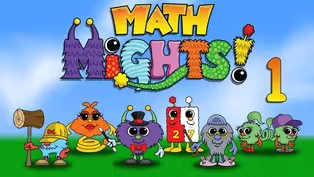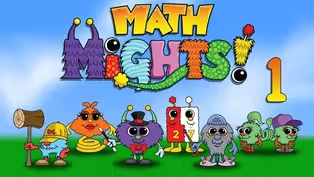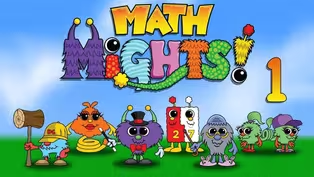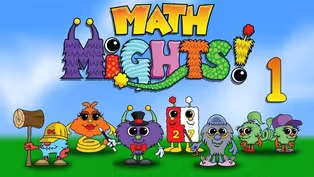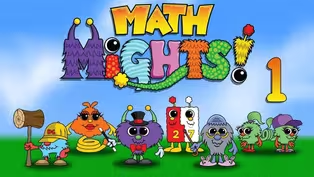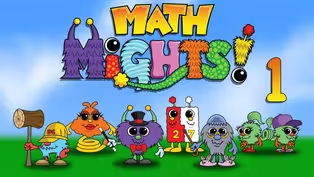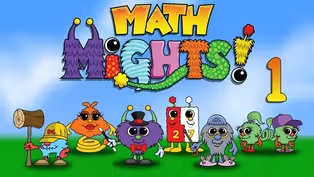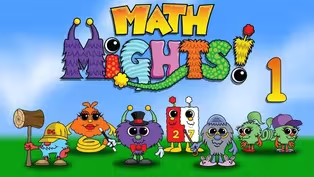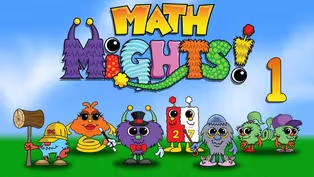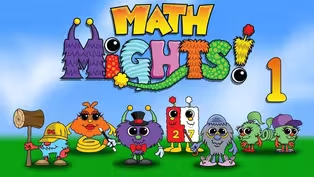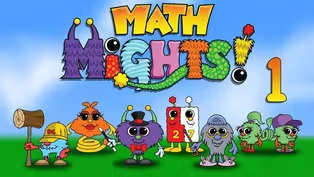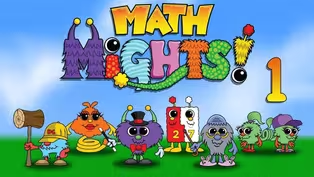Math Mights
Add 2-Digit Numbers & Write Equations
Season 3 Episode 305 | 15m 59sVideo has Closed Captions
Join Mrs. Markavich for a word problem with her friend Professor Barble!
Join Mrs. Markavich for a word problem with her friend Professor Barble! Next get ready to have some fun with Value Pak as we add 2-digit numbers using base ten strategies!
Problems playing video? | Closed Captioning Feedback
Problems playing video? | Closed Captioning Feedback
Math Mights is a local public television program presented by Detroit PBS
Math Mights
Add 2-Digit Numbers & Write Equations
Season 3 Episode 305 | 15m 59sVideo has Closed Captions
Join Mrs. Markavich for a word problem with her friend Professor Barble! Next get ready to have some fun with Value Pak as we add 2-digit numbers using base ten strategies!
Problems playing video? | Closed Captioning Feedback
How to Watch Math Mights
Math Mights is available to stream on pbs.org and the free PBS App, available on iPhone, Apple TV, Android TV, Android smartphones, Amazon Fire TV, Amazon Fire Tablet, Roku, Samsung Smart TV, and Vizio.
Providing Support for PBS.org
Learn Moreabout PBS online sponsorshipMore from This Collection
Video has Closed Captions
Join Mrs. Markavich for a missing addend word problem with Professor Barble! (16m 5s)
Adding Tens-Tens and Ones-Ones
Video has Closed Captions
Join Mrs. Markavich for a missing addend word problem with Professor Barble! (15m 35s)
Write Equations to Match the Strategy
Video has Closed Captions
Join Mrs. Markavich for a missing addend word problem with Professor Barble. (16m 2s)
Video has Closed Captions
Join Mrs. Markavich for a subtraction word problem with Professor Barble. (15m 59s)
Video has Closed Captions
Join Mrs. Markavich for a missing addend word problem. (16m 6s)
Comparing Numbers Different Ways
Video has Closed Captions
Value Pak shows you the different ways to compare 2-digit numbers. (15m 44s)
Video has Closed Captions
Join Mrs. Markavich for a word problem with her friend Professor Barble! (15m 59s)
Video has Closed Captions
Join Mrs. Markavich for a word problem with her friend Professor Barble! (15m 59s)
Decompose/Compose #'s Different Ways
Video has Closed Captions
We show you different ways to decompose and compose 2-digit numbers! (15m 59s)
Video has Closed Captions
Join Mrs. Markavich & Dotson to talk about numbers with the Counting Buddy Senior! (16m)
Video has Closed Captions
Join Mrs. Markavich & Dotson for a Numeracy Talk with the Counting Buddy Senior (16m)
Video has Closed Captions
Join Mrs. Markavich for Numeracy Talk with Dotson working on conservation to 20. (16m)
Providing Support for PBS.org
Learn Moreabout PBS online sponsorship(playful music) (electronic bells ringing) - [Children] Math Mights!
- Welcome back 1st grade Math Mights.
I'm Mrs. Markovich and I'm here to do so many fun things in math with you today.
Let's start out by checking out our plan for the day.
The first thing we're going to do is complete some word problems with my friend Professor Barble.
And then we're going to add two-digit numbers and write equations.
This is gonna be so much fun.
The first thing we always do is warm up our math brains.
And today we're going to have my friend Professor Barble here who loves to conquer word problems.
Here he comes now.
Let's check him out.
(triumphant music) Professor Barble loves to solve word problems.
He's so good at it.
And if he just stops and slows down a little bit before racing to the answer, and he pushes on his thinking cap, all of this really cool stuff pops out that helps them to solve these equations.
It helps him to slow down and think about what he should do next.
I want to take a look at something called a visual model.
You might ask yourself, hmm, what is a visual model?
A visual model is sometimes known as a model drawing, a unit bar, a tape diagram or a bar model.
We can use visual models as a reading comprehension strategy for word problems.
And we can draw a visual model and it will help us to visualize the strategies and understand what the word problem is asking.
In my 1st grade classroom, this is what a visual model would look like.
There would be a problem on top, a sentence, and then some more information on the paper.
Let's take a look at our first question.
It says, Emma has six green apples and Shannon has three red apples.
How many apples do they have in all?
Well, my friend Molly says, "I think maybe we should add to solve this problem."
And Han says, "Wait, or do we subtract?"
But here comes my friend Professor Barble and he says, "Whoa, guys, slow down.
"Let's use some of my tools to solve this.
"I have some steps to help us solve visual models."
The first part is to number one, read the entire problem and put it in chunks.
So let's do that now.
It says this: Emma has six green apples.
Chunk.
And Shannon has three red apples.
Chunk.
The next part says, how many apples do they have in all?
Chunk.
Step number two wants us to rewrite the question in a sentence form.
This helps us to slow our thinking down and really focus on what it is we're trying to solve here and not just rush to an answer.
The sentence form is, Emma and Shannon have hmm apples.
Step number three wants us to figure out who or what is involved in our problem.
So if you look at my example, you can see the who are my friends Emma and Shannon, and the what are the apples.
Step number four is to draw the unit bar.
And you can see on mine, the unit bar is blank this time.
If you remember from last time, I said I was gonna make it a little trickier.
Now step number five is really important.
We're going to take the information we chunked and we are going to add it into our visual model.
And we are going to check it off as we do it so that we don't miss any of our steps.
So let's do that right now.
Let's take a look at mine.
Mine says, Emma has six green apples.
We're going to go down to my unit bar and we're going to add that information.
But wait a minute.
It's not done for me, so I better read ahead a little bit more before I check that box off.
Let's read this part.
It says, and Shannon has three red apples.
Well, if Emma has six and Shannon has three, I don't think I could cut that right down the middle.
Emma has more, so I'm gonna move that line over like this.
On this part, I'm going to label it green because Emma had green apples.
And I'm going to write the number in here this time.
I'm going to put a six and I'm gonna go up here and make sure that I check it off.
On this side, Shannon had three red apples.
So I'm going to label red.
And then I'm going to add the number three this time, because Shannon had three red apples, and then I'm gonna make sure that I go back up there and check that information off.
My last part says, how many apples do they have in all?
Hmm, I bet this is where my question mark goes.
I'm going to put a question mark right here at the end.
Now I'm going to go back up here and I need to check it off.
Don't forget.
Check.
Our next step, step six, is to correctly compute the problem.
Han says, "Oh, now I see what the problem is asking.
"We need to add."
So I'm going to add six plus three.
Six plus three equals.
Hmm.
And I know that six, add three equals the number nine.
Emma and Shannon have a total of nine apples.
So my very last step in Professor Barble's steps is to add the nine into my sentence form.
Emma and Shannon have nine apples.
That was a lot of great work, 1st grade friends.
Now let's look at our I can statement for today.
I can add numbers and write equations to show my work.
Let's take a look at my friends.
I have Molly and Han.
They are both finding the sum to 24 plus 63.
My friend Molly started with 20 plus 60 equals 80.
What should she do next to find the sum?
Let's head over to my board and take a really close look at what my friend Molly does.
I have the equation up at the top.
24 plus 63 equals, hmm.
My friend Molly says, "I'm gonna start "by counting the tens first."
So she starts like this.
10, 20, and then she counts to 60.
10, 20, 30, 40, 50, 60.
And she knows that 20 plus 60 equals 80.
What?
Did I hear you say to add the ones?
Great thinking!
Let's do that now.
One, two, three, four.
One, two, three.
And I know that four ones plus three ones equal seven.
And I know that 24 plus 63 equals 87.
I'm gonna write that so that you can see what this looks like.
24 plus 63 equals 87.
Great problem solving skills, Molly!
Now let's take a look at my next friend Han.
Han solves this problem a completely different way.
My friend Han starts with 63, adds 20 to get 83.
What should he do next to find the sum?
This sounds complicated.
Han starts with the whole number of 63.
So I'm gonna slide that down so you can see it.
He has 10, 20, 30, 40, 50, 63 right here.
63.
And then he adds 20.
That's right here.
So he says 63, 73, 83.
What?
Did I hear someone say keep counting the ones?
Let's try it.
I have 83, 84, 85, 86, 87.
I'm gonna put the four ones there.
And now I know that 63 plus 24 equals 87.
Not only did Han switch that whole equation around, he also started with a whole number, added tens, and then added ones so that his equation looked like this.
63 plus 24 equals 87.
Take a look at that.
Both of my friends had the exact same equation.
They switched the numbers around because you can do that in adding.
They both solved it using a different strategy, and they came up with the exact same answer.
Now I think it's time for us to really put our minds to work.
I've got an equation for you, and I need you to really think about this while we try to solve it.
I want to know which expression was used to find the sum 24 plus 32.
Wow, I have a whole bunch there!
I have 30 plus 20, 32 plus 4, 24 plus 2, 32 plus 20, 24 plus 30 and 4 plus 2.
I think we need to take a look at my whiteboard and see if we can tackle this one together.
I wrote out the problem, 24 plus 32.
I used some tens and ones to model it for you.
I have two tens and four ones, and I have three tens and two ones to make 24 and 32.
Then I have all of our equations down here.
I'm gonna think back to my two friends.
One of my friends counted the tens first, and then she added the ones.
Do you see any equations down here that are adding just our tens?
So I think I might need 10, 20, and then 10, 20, 30.
Hmm, let me look.
Ooh, I see this one right here.
30, 10, 20, 30 plus 20, 10, 20.
But wait, I have to add my ones too.
Do you see anywhere on my board where there is an equation that is only adding the ones?
I need it to say one, two, three, four ones and one, two, two ones.
I think if I look really hard, ooh, I found it.
It's right here.
Four plus two.
So my guess is that the rest of these are not going to work.
I'm gonna move them right out of the way.
And now I'm gonna show you how to solve this equation.
I'm gonna take the tens.
30 plus 20 equals 50.
Then I'm going to add my ones.
Four plus two equals six.
Now you have to take both of the answers and add them together to get the whole number.
Let's try it.
50 plus 6 equals 56.
That was some great thinking, Math Mights!
You're doing such a great job at this.
Now I want to see if we can find the sum of 33 plus 46.
How would you solve it?
Oh, I think I heard someone say I would start with the bigger number, 46.
It's more efficient that way.
So let's start with the 46, and then let's count by tens.
And I know that I have three tens over here, so I'm going to say 46, and I'm gonna keep counting by tens.
56, 66, 76.
So I have 70.
I'm just gonna borrow this for a minute and show you 76.
I'll put it right back over there.
76.
Now I'm going to count the ones.
So I'm just going to count on.
76, 77, 78, 79.
Do you see how fast that was?
It was really quick when I started with the bigger number and then added the smaller number.
I added tens and then I added the ones.
So I know that 33 plus 46 equals 79.
Great job friends!
You were so efficient starting with the larger number and then adding the smaller number.
Now it's your turn to try and solve with tens and ones with Value Pak.
Thanks so much 1st grade Math Mights.
I had so much fun with you today.
I definitely think you need to double kiss your brain.
(lips smooching) See you next time!
(playful music) (cheerful whistling music) - [Boy] Sis4teachers.org.
- [Girl] Changing the way you think about math.
- [Announcer] This program is made possible with funding from the Michigan Department of Education, Governor's Education Emergency Funds, the State of Michigan, and by viewers like you.
(cheerful music continues)


- Home and How To

Hit the road in a classic car for a tour through Great Britain with two antiques experts.










Careers that Work

Support for PBS provided by:
Math Mights is a local public television program presented by Detroit PBS
